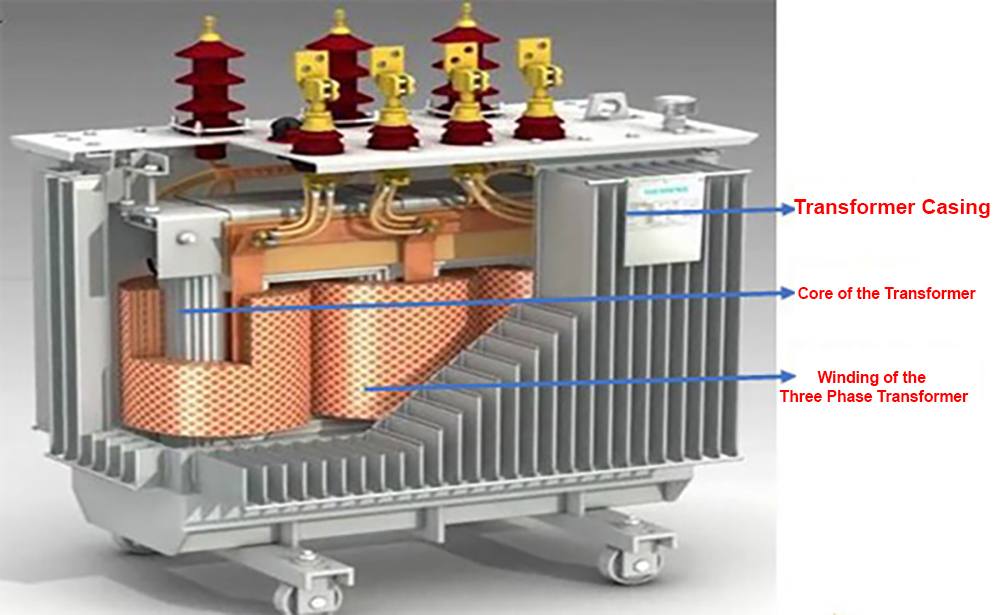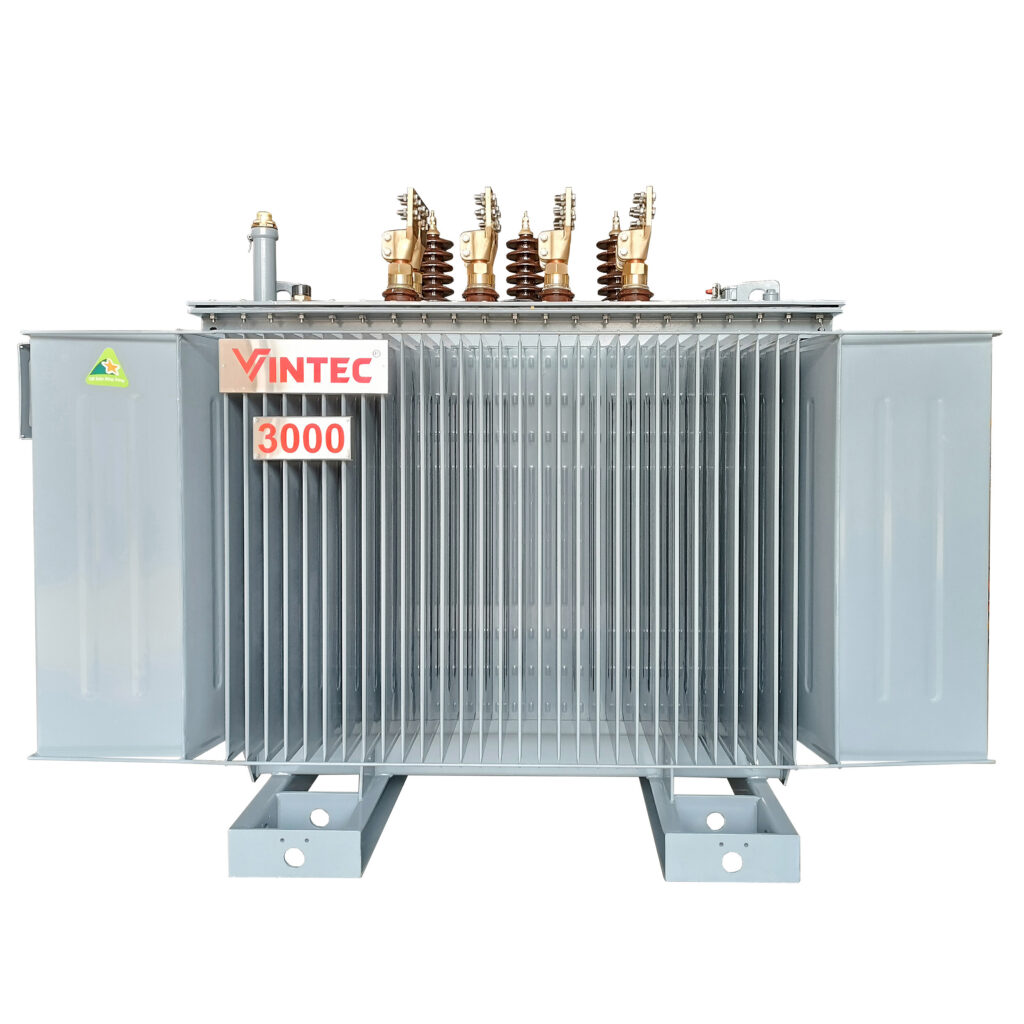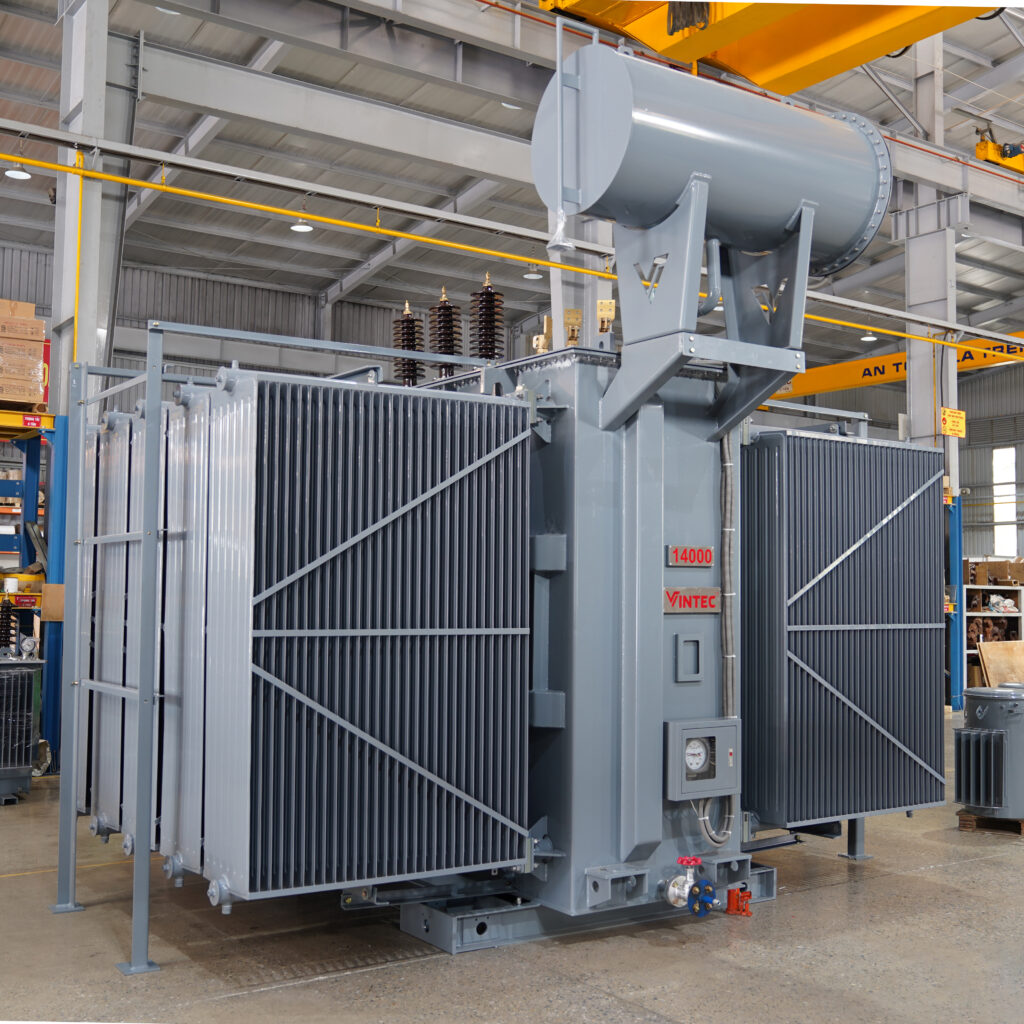1. What is a Three-Phase Oil-Immersed Transformer?
A three-phase oil-immersed transformer is a static electromagnetic device designed to transmit energy or transfer alternating current (AC) signals between electrical circuits through the phenomenon of electromagnetic induction described by Faraday’s law.
This type of transformer plays a vital role in power transmission systems. It is widely used for industrial purposes in generating, transmitting, and distributing electrical energy.
Three-phase oil-immersed transformers are typically installed in places with very high power consumption, such as skyscrapers, apartment buildings, hospitals, and electrical substations.

Image of Open-Type 3-Phase Oil-Immersed Transformer
2. Structure of a Three-Phase Oil-Immersed Transformer
To function effectively in large electrical grid systems, the three-phase oil-immersed transformer is relatively complex in design. Its main components include a magnetic core, windings, transformer casing, and several auxiliary parts.

Structure of a Three-Phase Oil-Immersed Image
2.1. Magnetic Core
The core consists of limbs and yokes. The limbs are where the windings are placed, while the yokes connect the limbs to form a closed magnetic path. The core is made from thin sheets of electrical steel (silicon steel), insulated from each other. These materials are chosen for their excellent magnetic conductivity.
2.2. Windings
The windings are typically made of copper or aluminum and are insulated externally. They function to receive electrical energy and transmit it to the load.
-
The primary winding (N1) receives the input energy (connected to the AC source).
-
The secondary winding (N2) delivers the output energy (connected to the load).
The number of turns in each winding differs depending on the transformer’s function — N1 may be greater or less than N2.
2.3. Transformer Casing
The casing may be made from plastic, wood, steel, cast iron, or sheet metal, depending on the transformer type. Its main purpose is to protect the internal components.
2.4. Auxiliary Components
To complete the structure of a 3-phase oil-immersed transformer, the following key auxiliary components are also included:
-
Transformer oil
-
Insulating bushings
-
Transformer base
-
Voltage gauge
3. Working Principle of a Three-Phase Oil-Immersed Transformer
The working principle of a three-phase oil-immersed transformer is based on two basic physical phenomena:
-
Current flowing through a conductor generates a magnetic field.
-
A varying magnetic flux through a coil induces an electromotive force (voltage).
Understanding this principle makes it easier to grasp how the transformer works and the methods required to ensure it operates efficiently and delivers the correct rated power.
4. Types of Three-Phase Oil-Immersed Transformers
Transformers are generally classified based on voltage levels, core materials, winding arrangements, usage, and installation environments. The most commonly used types of three-phase oil-immersed transformers today include:
4.1. Sealed-Type 3-Phase Oil-Immersed Transformer
This type is cooled through expansion fins. When the internal temperature increases, the fins expand, allowing air to flow directly through them to dissipate heat and cool the transformer.

Image of Sealed-Type 3-Phase Oil-Immersed Transformer
4.2. Open-Type 3-Phase Oil-Immersed Transformer
An open-type oil transformer includes a conservator tank. It is a distribution transformer with input voltages of 35kV, 22kV, or 10kV, and an output voltage of 0.4kV. It is immersed in standard insulating oil for cooling and insulation.

Image of Open-Type 3-Phase Oil-Immersed Transformer
4.3. Amorphous Transformer
An amorphous transformer is an energy-efficient type installed in power grids. Its core is made from amorphous ferromagnetic metal. A typical material (e.g., Metglas) is an alloy of iron with boron, silicon, and phosphorus in thin ribbons (e.g., 25 µm) that are rapidly cooled after melting.
These materials have high magnetic permeability, low coercivity, and high electrical resistance. Their thin form and high resistance result in minimal eddy current losses under alternating magnetic fields. However, amorphous alloys have lower magnetic saturation and often higher magnetic hysteresis compared to conventional crystalline silicon steel.
5. Where to buy a three-phase oil-immersed transformer?
With nearly 20 years of experience in manufacturing transformers and electrical equipment, Vintec Group is a leading manufacturer of three-phase oil-immersed transformer in Vietnam.



